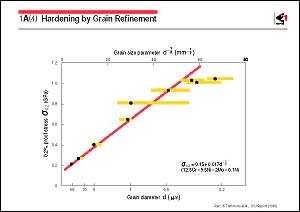There are four methods of increasing
the hardness of steel materials: (i) solid-solution hardening,
(ii) precipitation hardening, (iii) work hardening, and (iv)
hardening by grain refinement. Solid solution hardening, precipitation
hardening, and work hardening all decrease elongation and toughness,
although strength is increased. In contrast, hardening by grain
refinement does not have this undesirable effect. The effect
of grain size on hardening by grain refinement can be expressed
by the Hall-Petch relationship. This figure shows the relationship
between the grain size and strength obtained from measurements
of stainless steel of the same chemical composition and various
grain sizes. The increase in strength levels off for a grain
size of less than 0.5μm because subgrains with
a small-angle grain boundary contribute less to strengthening
than normal grains.
The grain size in the ordinary as-hot-rolled structural steels
is about 20μm. Grain sizes of 10-5μm can be obtained by controlling
the hot rolling conditions and the cooling conditions after hot
rolling, and the grains can be further refined to 5-1μm by quench-tempering.
However, this is the limit for the grain size that can be obtained
industrially. The figure shows that the yield stress is increased
by about 350 megapascals due to grain refinement from 20μm to
1μm. This increase means that the yield stress can be almost doubled
in a plain carbon steel. Therefore, techniques to materialize
much finer grains in an industrial manufacturing process are
expected to be developed to further increase material strength,
for which a better understanding of such basic phenomena as diffusion,
recrystallization, grain growth, precipitation, and transformation
will be required. |
|
 |
 |
 |
|
|